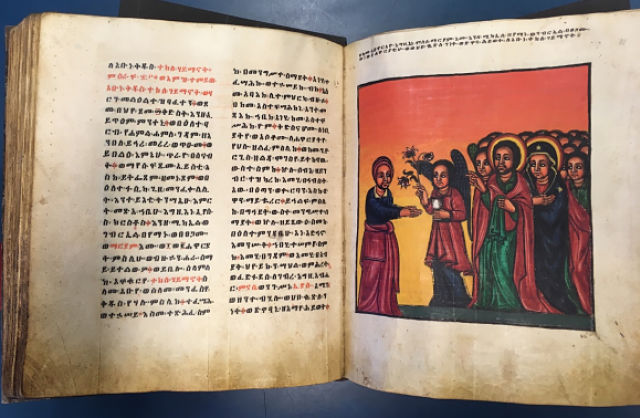 From the Life and Acts of St. Takla Haymanot. 18th century (Photo: Public Domain)
From the Life and Acts of St. Takla Haymanot. 18th century (Photo: Public Domain)
Tadias Magazine
By Tadias Staff
Published: January 7th, 2020
New York (TADIAS) — In a timely article titled “These are the monks who still preserve ancient texts around the world,” America Magazine highlighted the Ethiopian Manuscript Microfilm Library (EMML) undertaking and what happens to cultural heritage during war and turmoil.
According to cambridge.org, EMML “is a joint project of the Ethiopian Orthodox Church, the Hill Monastic Manuscript Library (HMML) (formerly Monastic Manuscript Microfilm Library) of St. John’s Abbey and University, Collegeville, Minnesota, U.S.A.” It was “established at the urging of His Holiness Abuna Tewoflos, Patriarch of the Ethiopian Orthodox Church, who was much concerned about the dangers of irreparable damage and loss to the manuscript treasures of his Church. The purpose of the project is twofold: To preserve on microfilm the precious treasures of manuscripts and to make those source materials available for study by scholars both within and outside Ethiopia. Efforts are also being directed toward obtaining copies of Ethiopian manuscripts outside of Ethiopia.”
The recent piece in America Magazine, written by Columba Stewart — the Executive Director of the Hill Museum & Manuscript Library in Collegeville, Minnesota — focuses on the conservation efforts geared towards ancient texts, which initially started as a project to microfilm European Latin manuscripts in the 1960s.
“It was two decades after the devastation of the Second World War, three years after the Cuban missile crisis and during a very chilly phase of the Cold War,” Stewart writes. “We feared that the European Benedictine heritage would be vaporized if there were a World War III. Monte Cassino in Italy, the mother abbey of the Benedictines, had been totally destroyed in 1944. A nuclear war would be far more devastating.”
In Stewart’s highlight of the microfilming efforts conducted in Ethiopia he noted the following:
Along the way there came a serendipitous event that changed the course of the project. An American scholar of biblical texts approached us with the idea of microfilming manuscripts in the monasteries and churches of Ethiopia. This great African nation is the home of an ancient Christian community that had never undergone the narrowing of the biblical canon—the official list of writings constituting the Christian Bible—that occurred in other parts of the early Christian world. Consequently, Ethiopian Christians preserved a broad array of writings later excluded from the Bible of the Byzantine and Roman traditions. Microfilming began in 1971, with the work done by Ethiopians, the technical support from us and funding from the National Endowment for the Humanities, among other foundations.
The cameras kept going, working throughout the 1970s, 1980s and into the early 1990s. In the end, 9,000 manuscripts were microfilmed under often-harrowing circumstances.
The situation in Ethiopia worsened when a violent revolution deposed the emperor and installed a communist government hostile to the church. What had begun as a kind of archeological expedition to discover ancient texts became a rescue project to preserve manuscripts in a nation convulsed by political upheaval and then a civil war. The cameras kept going, working throughout the 1970s, 1980s and into the early 1990s. In the end, 9,000 manuscripts were microfilmed under often-harrowing circumstances.
The Ethiopian Manuscript Microfilm Library also demonstrates what happens to manuscripts in times of turmoil. A few years back, a professor from Howard University approached one of our experts for help identifying an Ethiopian manuscript recently donated to the university. She showed him photographs of the manuscript, and he recognized it as one of the thousands microfilmed in our project. After it was photographed in 1976, the manuscript had been taken out of Ethiopia and found its way into a private collection in the United States.
Unlike most stories of this kind, this one had a happy ending: Howard University repatriated the manuscript to the monastery in Ethiopia from which it had been taken. Sadly more typical is the case of another, even more valuable, Ethiopian manuscript microfilmed in the 1970s. That one is now in a well-known private collection. In its online catalog, the provenance given for the manuscript is simply the name of the dealer from whom it was purchased.
By the time those manuscripts were taken out of Ethiopia, the colonial era was over. International protocols and national laws regulated the export of cultural heritage. Neither of these manuscripts should have adorned a private collection or enriched a dealer. This story illustrates two of the greatest threats to cultural heritage: the desperation that leads people to sell off their own heritage in order to feed their families and the profiteering by those who exploit that misfortune.
Read the full article at americamagazine.org »
—
Join the conversation on Twitter and Facebook.

























